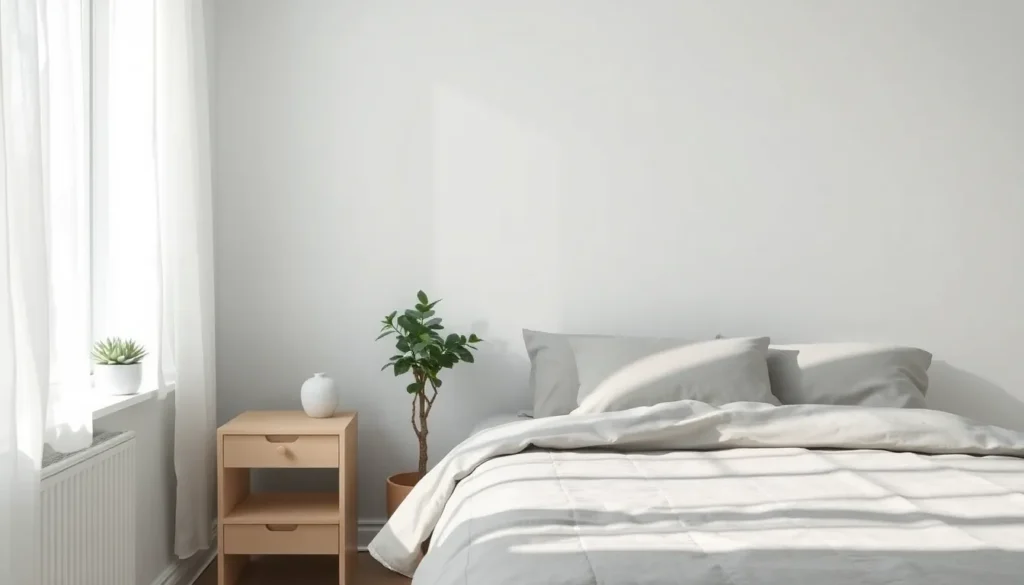We’ve all dreamed of creating that perfect bedroom sanctuary – a space that’s both calming and stylish without feeling cluttered or overwhelming. Minimalist bedrooms with plants offer the ideal solution, combining clean lines and intentional design with the natural beauty and air-purifying benefits of greenery.
The magic happens when we strip away unnecessary elements and let carefully chosen plants become our room’s focal points. This approach doesn’t just create visual appeal – it transforms our sleeping space into a peaceful retreat that promotes better rest and mental clarity.
Whether you’re working with a small apartment bedroom or a spacious master suite, we’ll show you how to master this trend that’s taking interior design by storm. From selecting the right low-maintenance plants to arranging them for maximum impact, creating your own minimalist plant haven is easier than you might think.
Choose the Right Plants for Your Minimalist Bedroom Space
We’ll help you select plants that complement your minimalist bedroom design while requiring minimal care and maintenance.
Low-Maintenance Succulents and Cacti
Succulents thrive in bedroom environments with their water-storing capabilities and sculptural forms. These plants require watering only once every 7-14 days, making them perfect for busy lifestyles. Popular varieties like jade plants, echeveria, and string of pearls add geometric shapes that align with minimalist principles.
Cacti bring architectural interest to your space without overwhelming the clean aesthetic. Small barrel cacti, prickly pear varieties, and moon cacti create striking focal points on nightstands or floating shelves. We recommend choosing specimens under 6 inches tall to maintain proper scale in bedroom settings.
Placement near windows ensures these desert plants receive adequate light for healthy growth. South-facing windows provide ideal conditions, though east-facing exposure works well for most succulent varieties. Terra cotta pots enhance the natural look while providing proper drainage these plants need.
Air-Purifying Snake Plants and ZZ Plants
Snake plants excel at removing toxins from bedroom air while tolerating low light conditions. NASA studies show these plants filter formaldehyde, xylene, and toluene from indoor air during nighttime hours. Their upright, sword-like leaves create vertical lines that draw the eye upward, making rooms appear larger.
ZZ plants offer glossy, dark green foliage that adds sophisticated texture to minimalist spaces. These plants can survive in fluorescent lighting and require watering only when soil becomes completely dry. Their naturally symmetrical growth pattern complements the organized nature of minimalist design.
Both varieties handle neglect exceptionally well, making them ideal for bedroom placement. Snake plants can go 2-3 weeks without water, while ZZ plants tolerate even longer periods of drought. We suggest placing them in corners or beside dressers where they won’t interfere with daily routines.
Compact Pothos and Philodendron Varieties
Pothos varieties bring trailing greenery that softens hard lines in minimalist bedrooms. Golden pothos, marble queen, and neon varieties offer different color variations while maintaining the same easy-care requirements. These plants grow well in hanging planters or on high shelves where their vines can cascade naturally.
Philodendron species provide heart-shaped leaves that add organic curves to angular bedroom furniture. Heartleaf philodendrons and Brasil varieties tolerate low to medium light conditions found in most bedrooms. Their compact growth habit makes them suitable for small spaces like nightstands or window sills.
Training these plants on moss poles or wall-mounted trellises creates living art installations. This vertical growing method saves floor space while adding height and visual interest to blank walls. We recommend using minimal, sleek support structures that won’t clash with your bedroom’s clean aesthetic.
Select Clean-Lined Planters That Match Your Aesthetic
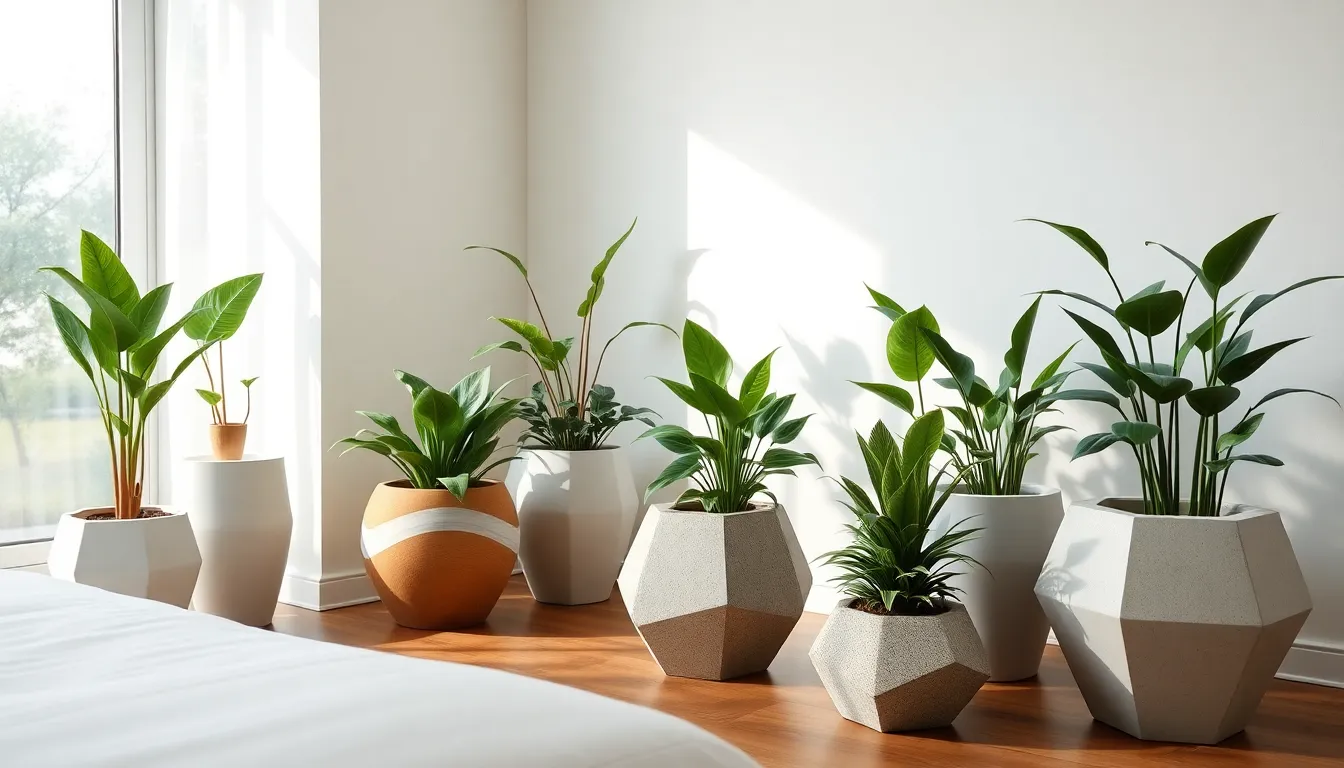
Choosing the right planters becomes crucial for maintaining that cohesive minimalist look we’re building. We’ll focus on three planter styles that perfectly complement our plant selections while improving the serene atmosphere.
White Ceramic Pots for Timeless Appeal
White ceramic planters offer the most versatile foundation for our minimalist bedroom design. These classic containers enhance brightness throughout the space while maintaining that clean, distraction-free aesthetic we want to achieve.
Ceramic’s smooth surface creates visual continuity with modern bedroom elements like crisp white linens and streamlined furniture. We can pair these planters with virtually any plant variety, from our recommended snake plants to trailing pothos, without disrupting the room’s peaceful flow.
The timeless nature of white ceramic means our investment will remain stylish as our bedroom evolves. These planters reflect light naturally, making smaller bedrooms appear more spacious while keeping the focus on our carefully selected greenery.
Natural Wood Planters for Warmth
Wood planters introduce organic warmth that balances the cool simplicity of minimalist design principles. Natural grain patterns add subtle visual interest without overwhelming our clean-lined aesthetic, creating that perfect harmony between structure and nature.
We can choose from light oak tones that complement Scandinavian-inspired bedrooms or deeper walnut shades for rooms with richer color palettes. Wood containers work exceptionally well with our geometric succulents and air-purifying ZZ plants, creating textural contrast that feels intentional rather than cluttered.
These planters age beautifully over time, developing character that enhances rather than detracts from our minimalist sanctuary. The organic material connects our indoor plants to their natural origins while maintaining the sophisticated look we’re cultivating.
Geometric Concrete Containers for Modern Edge
Concrete planters in geometric shapes bring sculptural elements that transform our plants into living art pieces. These containers offer raw, neutral textures that create striking contrast with the soft greenery of our selected plants.
Angular concrete designs work particularly well with our recommended peace lilies and snake plants, emphasizing their architectural qualities. The industrial material adds contemporary sophistication while remaining completely neutral in our color scheme.
We can position these statement planters as focal points on nightstands or floor corners, where their weight and presence anchor the room’s design. Concrete’s durability ensures these containers will maintain their modern edge for years while supporting our plants’ growth needs.
Position Plants Strategically Without Creating Clutter
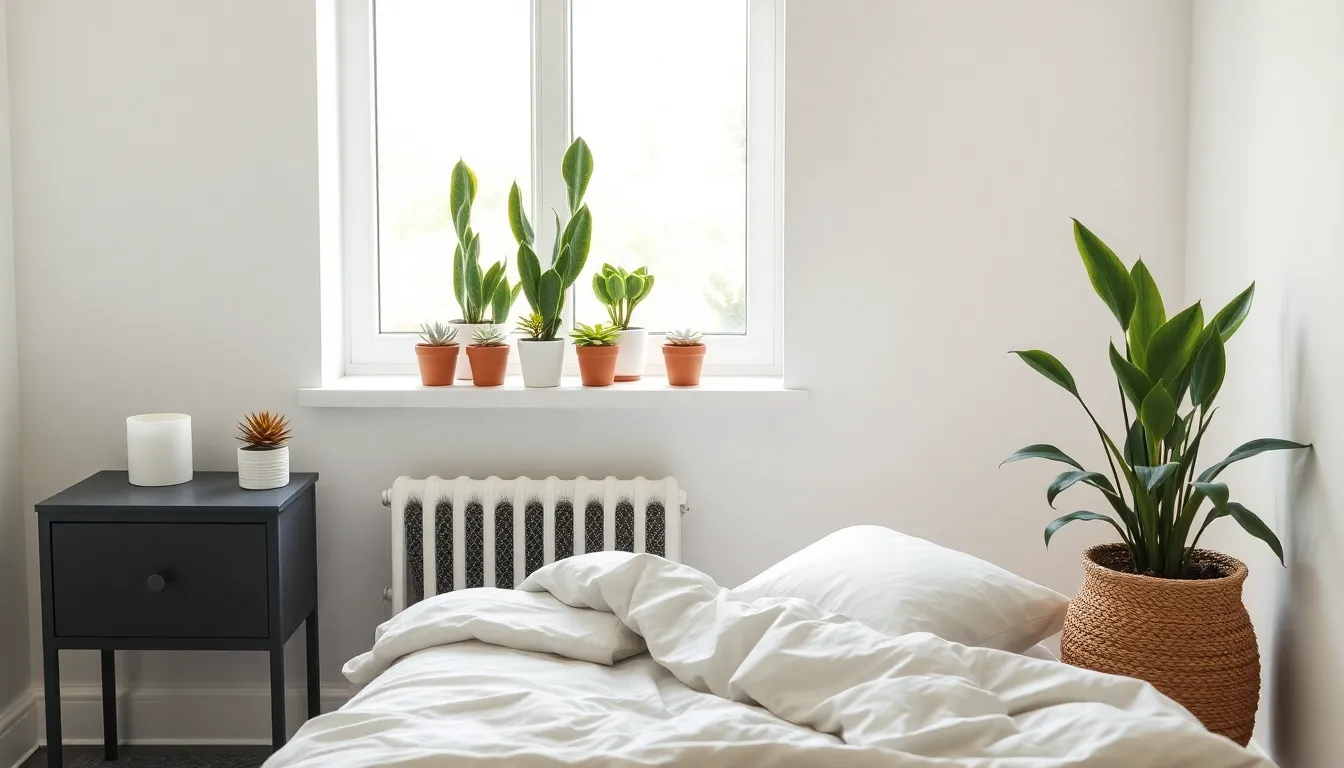
We’ve found that thoughtful placement maximizes greenery while maintaining the clean aesthetic essential to minimalist design. Strategic positioning prevents overwhelm and creates visual balance throughout your bedroom sanctuary.
Nightstand Corner Placement
Place a single small potted plant like a succulent or air plant on your nightstand to add life without overwhelming the surface. We recommend selecting plants that stay compact and won’t outgrow their designated space within months.
Choose muted-tone pots that blend seamlessly with your existing decor to maintain the minimalist look. These neutral containers ensure the plant acts as a subtle accent piece rather than a distracting focal point.
Position the plant toward the back corner of your nightstand to keep the front area clear for essentials like a lamp or book. This placement creates depth while preserving functionality for your bedtime routine.
Window Sill Arrangements
Group compact plants that benefit from natural light such as succulents or small snake plants along your windowsill for optimal growing conditions. We’ve seen that clustering 2-3 similar plants creates visual cohesion without appearing cluttered.
Arrange plants neatly in woven baskets or simple pots to keep the display orderly and consistent with minimalist principles. Uniform containers help create a curated look that feels intentional rather than random.
Space plants evenly across the sill to allow each one room to thrive while creating a balanced visual line. This spacing prevents overcrowding and ensures adequate air circulation between plants.
Floor Plant Positioning Rules
Avoid overcrowding the floor by placing only one or two larger plants like a ZZ plant or peace lily in corners to use unused space. We recommend keeping walking areas completely clear to maintain the open feeling essential to minimalist design.
Use corner plant stands or ladder shelves to elevate plants off the floor and preserve open space while adding greenery at different heights. These vertical answers draw the eye upward and create a sense of spaciousness.
Position floor plants away from high-traffic areas to prevent accidental bumping and maintain clear pathways throughout your bedroom. Strategic corner placement keeps plants safe while maximizing their visual impact in otherwise unused spaces.
Create Visual Balance With Plant Heights and Textures
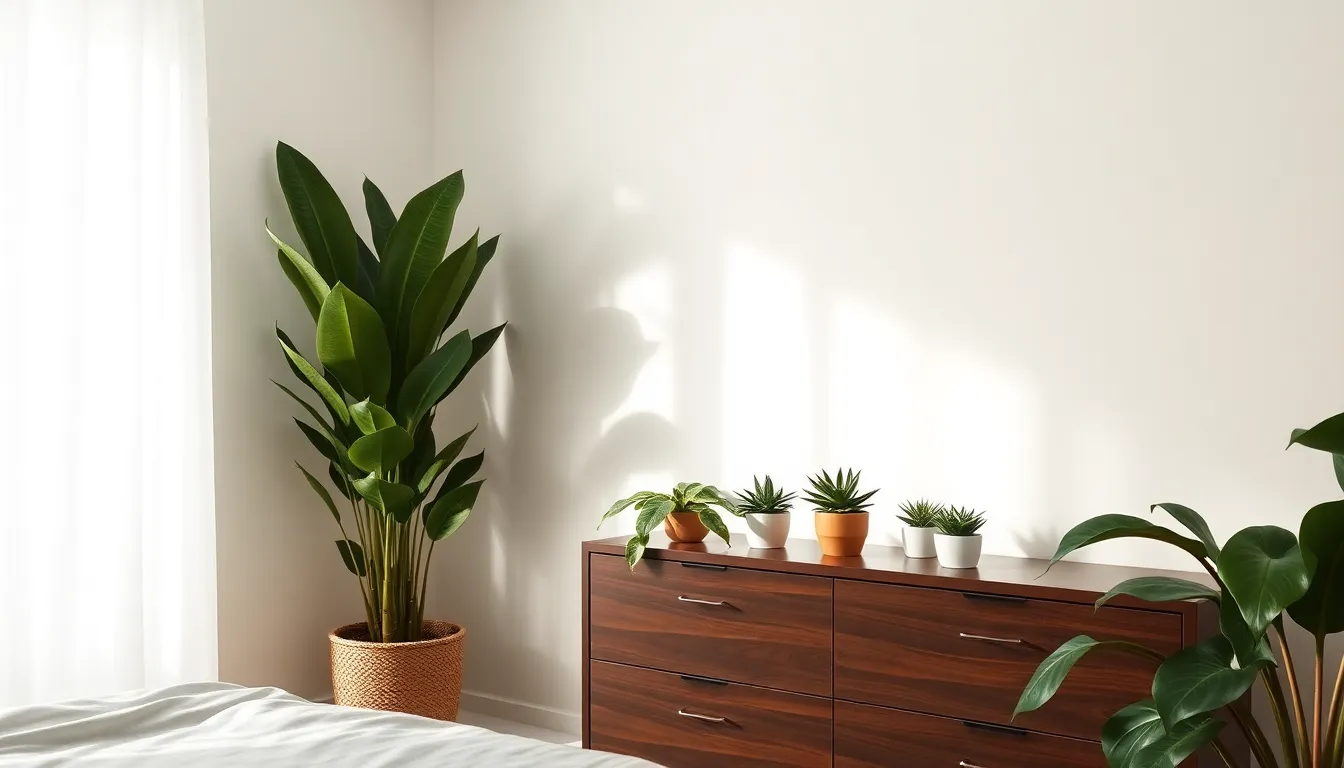
Visual balance transforms a minimalist bedroom into a harmonious sanctuary. We’ll explore how strategic plant placement creates depth while maintaining the clean aesthetic you desire.
Mixing Tall and Short Plant Varieties
Tall plants paired with shorter companions create natural depth that enhances your bedroom’s visual appeal. We recommend placing a tall snake plant or ZZ plant in one corner while positioning shorter succulents or a spider plant on nearby surfaces. This height contrast prevents monotony and adds dimension without compromising the minimalist principles we’ve established.
Corner placement works particularly well for taller varieties since they anchor the space without interfering with daily activities. We suggest limiting tall plants to one or two specimens to avoid overwhelming the room’s serene atmosphere. Spider plants on nightstands or dressers complement floor plants beautifully while adding gentle movement through their cascading leaves.
Combining Different Leaf Shapes and Colors
Varied leaf textures bring richness to minimalist spaces without creating visual clutter. We achieve this by pairing plants with sleek, glossy leaves like the ZZ plant alongside more delicate foliage such as the peace lily’s broad leaves or pothos trailing vines. This textural contrast adds softness and visual interest while maintaining the intentional design approach.
Glossy surfaces reflect light and create brightness in your bedroom sanctuary. We find that combining these reflective leaves with matte or textured foliage creates captivating visual layers. Peace lilies contribute elegant broad leaves that balance the linear forms of snake plants, while pothos vines introduce organic curves that soften geometric planters.
Using Odd Numbers for Natural Groupings
Odd numbered groupings mirror nature’s asymmetry and create more visually appealing arrangements than even numbers. We recommend grouping plants in sets of three or five to achieve this organic feel while maintaining minimalist intentionality. This approach prevents overcrowding while establishing natural focal points throughout your bedroom.
Three plant groupings work exceptionally well on surfaces like dressers or floating shelves where we can vary heights and textures. We avoid creating symmetrical pairs since they feel forced and detract from the relaxed atmosphere we’re cultivating. Natural asymmetry feels more authentic and supports the tranquil environment that defines minimalist bedroom design.
Maintain Clean Lines With Proper Plant Care Tools
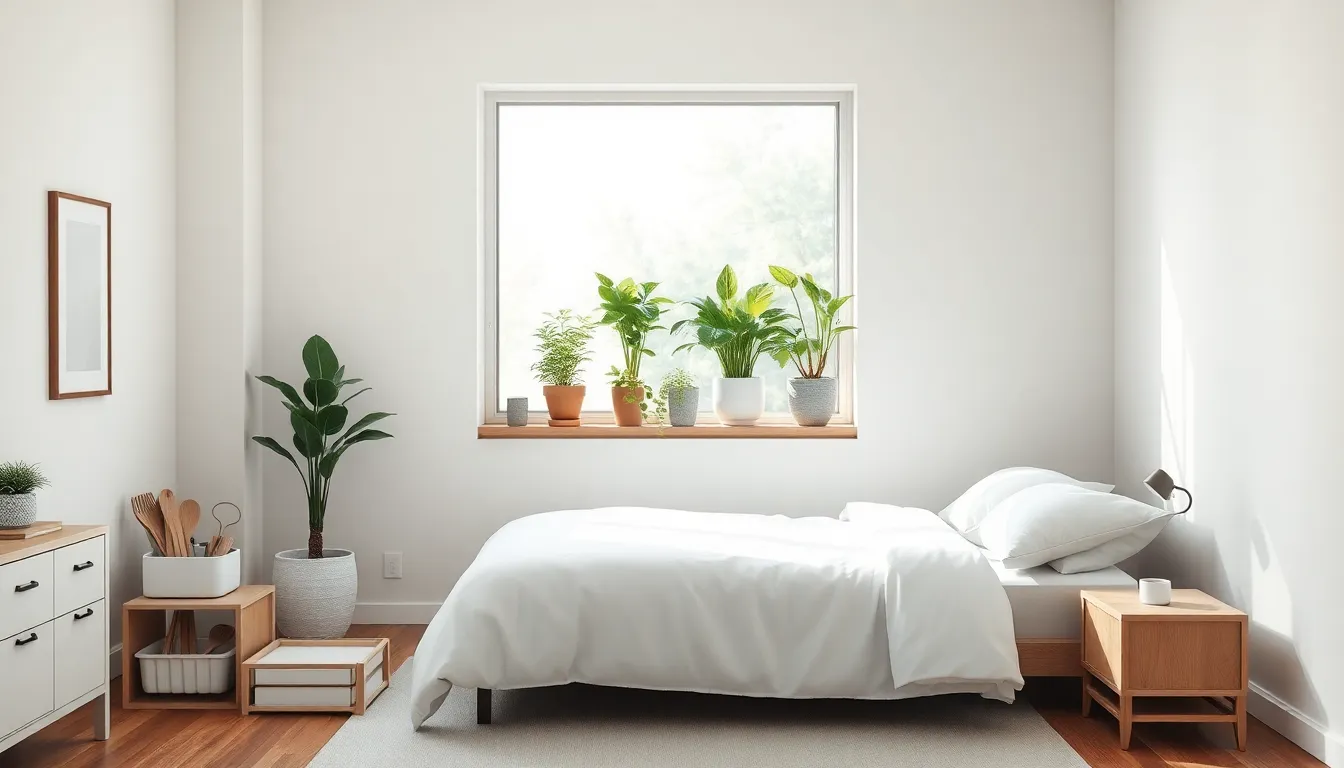
We can preserve the minimalist aesthetic of our bedroom while keeping plants healthy by strategically organizing our care essentials. Smart storage answers and intentional tool selection help us maintain the clean, uncluttered look that defines minimalist design.
Hidden Storage for Watering Equipment
Concealed containers keep our watering tools invisible while maintaining easy access for plant care. We recommend using small baskets, drawers, or sleek storage boxes tucked beneath the bed or inside nightstand compartments to store watering cans and spray bottles. Floating nightstands with hidden drawers provide perfect spots for compact watering equipment without adding visual weight to the room.
Under bed storage boxes work exceptionally well for larger watering cans and plant feeding supplies. We suggest choosing storage answers in neutral colors that blend seamlessly with existing bedroom decor. Built in closet organizers can accommodate fertilizers and plant food containers while keeping them completely out of sight.
Minimalist Plant Care Accessories
Neutral colored tools in simple designs integrate perfectly with our minimalist bedroom without creating visual disruption. We select pruning shears, plant misters, and small shovels in white, beige, or natural wood finishes that complement our plant containers. Ceramic or bamboo plant care accessories maintain the clean aesthetic while providing functionality.
Multi purpose tools reduce clutter by combining several functions into single items. We choose compact, sleek designs that can double as decorative elements when briefly visible during plant care routines. Matching tool sets in consistent materials create cohesion and prevent the scattered look that disrupts minimalist principles.
Scheduled Maintenance Routines
Regular care schedules keep our plants thriving while preventing maintenance tasks from overwhelming our peaceful space. We establish weekly plant check routines that include watering, pruning dead leaves, and rotating plants for even growth. Quick daily visual inspections help us catch issues before they require extensive intervention.
Incorporating plant maintenance into our existing cleaning schedule maintains consistency and prevents neglect. We designate exact days for different tasks like watering on Wednesdays and pruning on Sundays to create predictable routines. Simple care tracking through phone apps or minimal wall calendars helps us stay organized without adding physical clutter to our bedroom sanctuary.
Integrate Plants With Your Existing Bedroom Decor
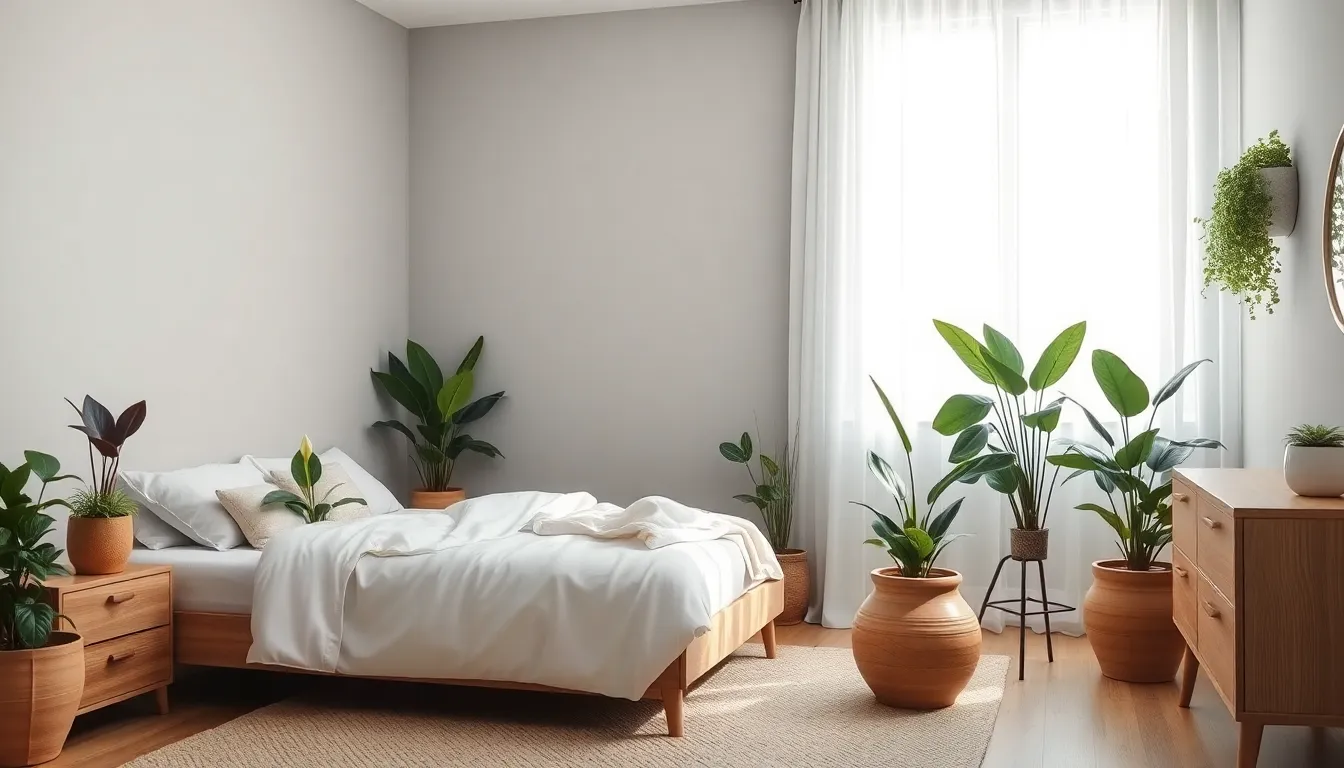
We’ll explore how to seamlessly blend your carefully selected plants with your current bedroom elements. This approach ensures your greenery enhances rather than disrupts your minimalist sanctuary.
Coordinating With Neutral Color Palettes
We recommend working with your existing neutral palette of soft grays, whites, blush, and earthy tones to create stunning plant displays. Dark green foliage from plants like peace lilies and ZZ plants creates beautiful contrast against these subdued colors, adding freshness without overwhelming the space’s subtlety.
Bright green leaves naturally complement soft color schemes while maintaining the minimalist aesthetic. For example, pairing soft blush throws with vibrant green pothos brings warmth and softness to austere spaces. We suggest using plant themed wallpaper or decorative pillows to reinforce the natural theme while preserving your neutral color foundation.
Snake plants with their architectural leaves work exceptionally well against white walls, creating visual interest through natural geometry. Peace lilies offer elegant white blooms that echo your existing neutral palette while their dark green leaves add depth and tranquility symbolism.
Complementing Natural Materials and Textures
We integrate plants alongside your natural materials like oak furniture, dark hardwood shelves, and exposed brick walls to enhance organic authenticity. Plants naturally echo these textures, creating harmony throughout your minimalist bedroom design.
Clay and ceramic planters in simple forms further the tactile connection without distracting from your room’s simplicity. Woven fabric textures pair beautifully with trailing plants like pothos, which soften clean furniture lines and add organic curves.
Elements like wrought iron frames work alongside plants to enrich industrial or rustic minimalist styles. We recommend choosing planters that mirror your existing natural materials, such as matching wood tones or complementary stone textures, to maintain design coherence.
Improving Natural Light Sources
We position plants strategically near windows to maximize natural light benefits for both plant health and visual impact. Natural light highlights your greenery’s beauty while promoting healthy plant growth in your minimalist sanctuary.
Sheer curtains or minimal window treatments keep rooms bright and airy, allowing plants to thrive. ZZ plants and peace lilies tolerate low light conditions but flourish with indirect sunlight, reinforcing your bedroom’s calm ambiance.
We suggest placing light loving plants on windowsills where they receive optimal exposure while maintaining your room’s open feel. Strategic positioning near natural light sources ensures your plants remain healthy focal points that enhance rather than compete with your existing decor elements.
Avoid Common Mistakes in Minimalist Plant Design
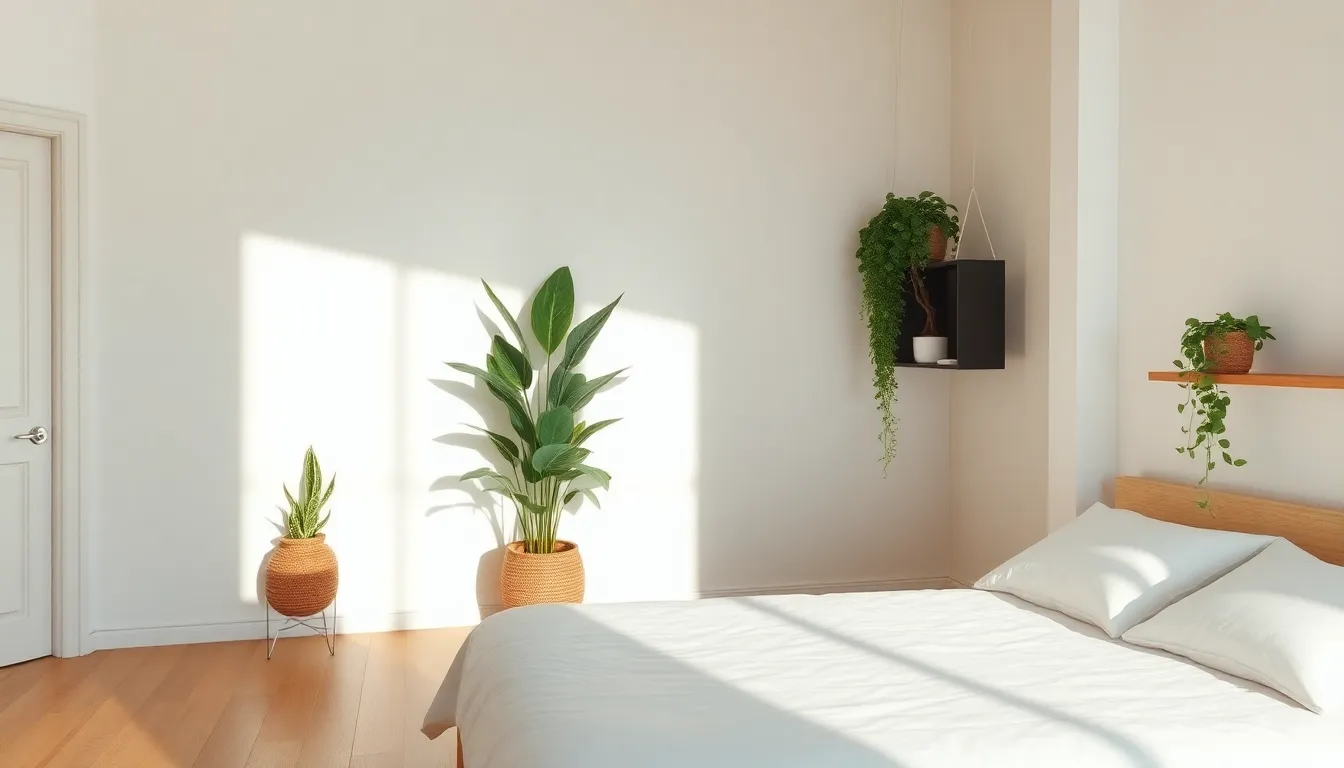
We’ll help you steer clear of the most common pitfalls that can disrupt your carefully curated minimalist bedroom sanctuary. Creating the perfect balance requires understanding what not to do as much as what to embrace.
Overcrowding Your Space With Too Many Plants
Resist the temptation to fill every available surface with greenery. Minimalism thrives on clean, uncluttered spaces that promote tranquility and rest. Overloading your bedroom with many plants disrupts the serene vibe and makes the room feel chaotic rather than peaceful.
Select only a few well-placed plants to create meaningful focal points. We recommend limiting yourself to three to five plants maximum, depending on your room size. Each plant should serve a exact purpose in your design, whether it’s adding height to a corner or bringing life to your nightstand.
Focus on quality over quantity when building your plant collection. One stunning snake plant or ZZ plant makes a more powerful visual impact than multiple small, scattered succulents. This approach maintains the breathing room that’s essential to minimalist design while still incorporating the natural elements you crave.
Choosing High-Maintenance Varieties
Avoid plants that require frequent watering, pruning, or special care routines. High-maintenance varieties can add stress to your daily routine and detract from your bedroom’s tranquil atmosphere. Finicky plants also tend to show signs of distress quickly, disrupting the clean aesthetic you’ve worked to achieve.
Opt for resilient species that thrive with minimal intervention. Succulents, cacti, and snake plants excel in minimalist bedrooms because they require minimal watering and can tolerate varying light conditions. These low-maintenance champions let you enjoy greenery without the constant worry about plant care.
Choose plants that fit your lifestyle and schedule. We understand that busy schedules don’t always allow for daily plant maintenance. ZZ plants and pothos varieties can go weeks between waterings, making them perfect for frequent travelers or those with demanding work schedules.
Ignoring Scale and Proportion
Match your plant sizes to your room dimensions and furniture scale. Large, bulky plants can overpower small bedrooms, while tiny plants may get lost in spacious rooms. The key is finding plants whose size and shape enhance your room’s natural balance rather than competing with it.
Consider the visual weight of each plant in relation to your space. A tall snake plant works beautifully in a corner beside a low dresser, while a trailing pothos adds softness when placed on a high shelf. We recommend measuring your intended plant locations before shopping to ensure proper proportions.
Think about growth patterns when selecting your green companions. Some plants like philodendrons can grow quite large over time, potentially disrupting your carefully planned layout. Peace lilies and Chinese evergreens maintain more predictable sizes, making them excellent choices for long term minimalist designs.
Conclusion
We’ve shown you how to transform your bedroom into a minimalist sanctuary where carefully chosen plants create the perfect balance of tranquility and natural beauty. By selecting low-maintenance varieties and positioning them strategically you’ll achieve that coveted serene atmosphere without sacrificing style or functionality.
Remember that less truly is more in minimalist design. Focus on quality over quantity and let each plant serve as an intentional element that enhances your space rather than clutters it.
Your minimalist bedroom with plants isn’t just about following trends—it’s about creating a personal retreat that supports better sleep and mental clarity. With the right approach you’ll wake up each morning in a space that feels both refreshing and perfectly balanced.
Frequently Asked Questions
What are the best low-maintenance plants for a minimalist bedroom?
Succulents, cacti, snake plants, and ZZ plants are ideal choices for minimalist bedrooms. These varieties require minimal watering, tolerate low light conditions, and provide air-purifying benefits. Snake plants and ZZ plants work well in corners, while succulents and cacti add geometric shapes that complement clean minimalist lines without overwhelming the space.
How many plants should I include in my minimalist bedroom?
Limit your bedroom to 3-5 plants maximum to maintain the serene, uncluttered aesthetic essential to minimalism. Focus on quality over quantity by selecting statement pieces rather than filling every surface. This approach ensures your plants serve as intentional focal points while preserving the calm, spacious feeling that defines minimalist design.
What types of planters work best for minimalist bedroom decor?
White ceramic pots, natural wood planters, and geometric concrete containers are perfect for minimalist bedrooms. White ceramics enhance brightness and offer timeless appeal, wood planters add warmth while maintaining clean lines, and concrete containers provide modern sculptural elements. Choose planters with simple, geometric shapes that complement your existing neutral color palette.
Where should I position plants in my minimalist bedroom?
Place one small plant on your nightstand, group compact plants on window sills in uniform containers, and position 1-2 larger floor plants in corners. Use plant stands or shelves to elevate plants and maintain open floor space. This strategic placement maximizes greenery while preserving the clutter-free aesthetic essential to minimalist design.
How do I maintain plants without cluttering my minimalist space?
Store watering tools and plant care accessories in concealed storage like small baskets or under-bed boxes. Choose neutral-colored, simple care tools that blend with your decor. Establish a regular maintenance routine by incorporating plant care into your existing cleaning schedule, ensuring plants thrive while maintaining your bedroom’s serene atmosphere.
What common mistakes should I avoid when adding plants to a minimalist bedroom?
Avoid overcrowding with too many plants, choosing high-maintenance varieties that create stress, and selecting plants that don’t match your room’s proportions. Don’t forget to consider growth patterns when positioning plants, and resist the urge to fill every empty space. Remember that minimalism emphasizes intentional choices and negative space.

